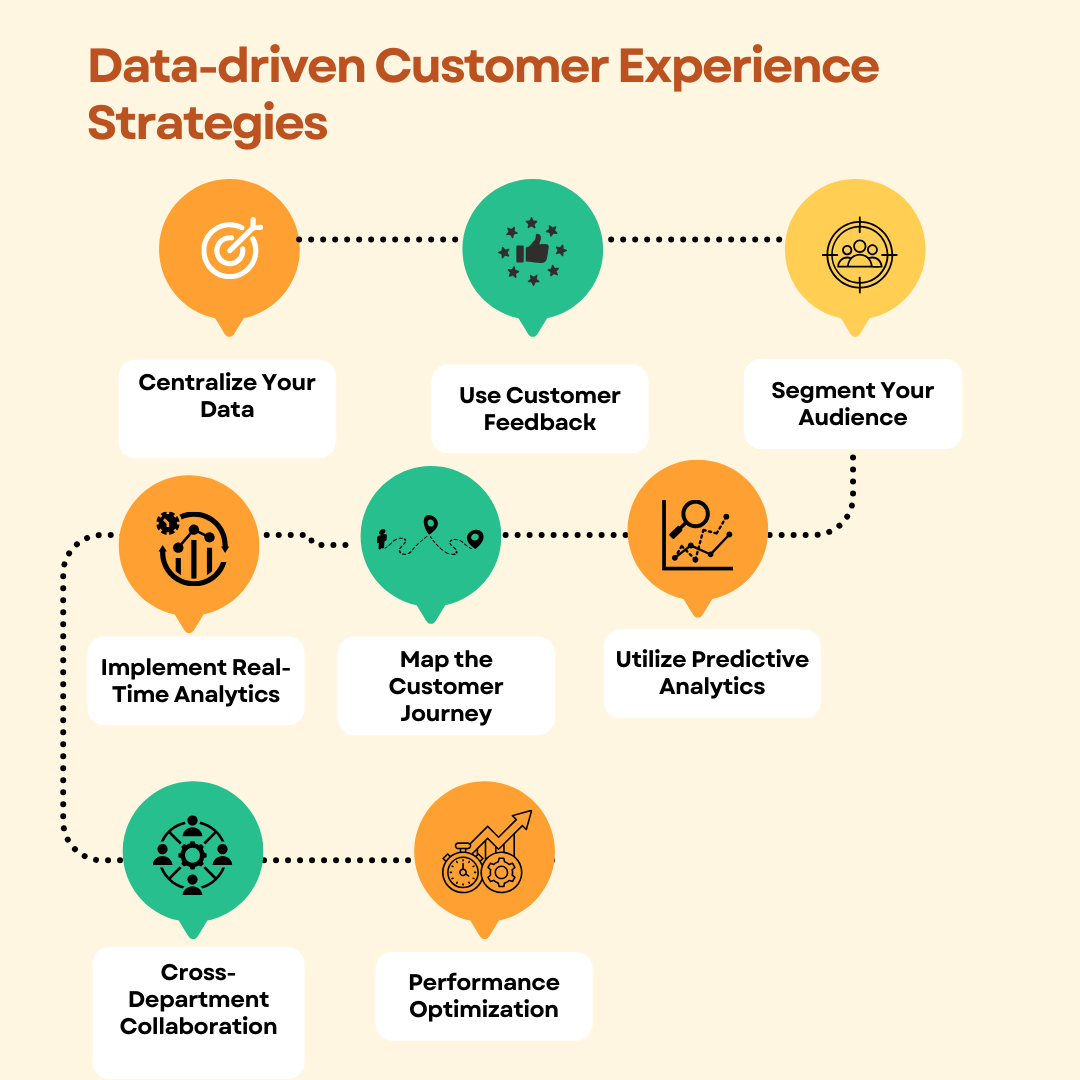What if you could predict what your customers want before they even know it themselves? Imagine delivering exactly what they need, just at the right time, across every touchpoint of their journey. The businesses that succeed are using data to read between the lines, anticipate needs, and craft personalized experiences that leave lasting impressions.
But how does data truly shape the customer experience? And more importantly, how can businesses harness it in a way that feels seamless, personalized, and even predictive? This is where data-driven customer experience comes into the picture.
In this blog, we’ll dive into how companies can implement data to build transformative customer experiences. We’ll also explore how Valuebound empowers businesses to unlock the power of data, ensuring every customer interaction feels personalized, meaningful, and impactful.
Why Data-Driven Customer Experience Matters
The use of data in customer experience management allows businesses to make informed decisions based on real insights rather than assumptions. By analyzing data from multiple touchpoints, companies can identify trends, track customer journeys, and uncover areas that need improvement. Here's why making data-driven decisions is critical:
1. Improve Decision-Making
Data provides concrete evidence that helps businesses make smarter decisions. Whether refining marketing strategies, developing new products, or improving customer support, data-driven insights guide decisions that are more likely to yield positive outcomes and reduce risk.
2. Measure CX Performance
Tracking the right customer experience metrics is essential to measure the effectiveness of CX initiatives. Metrics such as Net Promoter Score (NPS), Customer Satisfaction Score (CSAT), and Customer Lifetime Value (CLV) help businesses understand how well they are performing in terms of customer experience and where improvements are needed.
3. Building Customer Trust
Trust is the foundation of any successful relationship, businesses and customers included. Data allows businesses to build this trust by showing customers they truly understand their needs and preferences. When customers feel that a brand "gets them," it strengthens the bond and enhances the overall experience.
Connecting Data with Customer Experience
Data offers insights into what customers want, how they behave, and what frustrates them. With the right tools, data becomes a powerful asset to enhance the customer experience. Here’s how data and customer experience work together:
End-to-End Visibility
Data allows businesses to gain a holistic view of the entire customer journey from when a potential customer first engages with your brand to post-purchase interactions. This visibility helps businesses see the complete picture, enabling them to deliver a consistent, high-quality experience at every stage.
Adaptability
With access to real-time data, businesses can quickly adapt to changing customer preferences. Customer feedback, website interactions, and social media engagement provide instant insights, allowing businesses to make adjustments and ensure they always meet customer expectations.
Enhance the Digital Experience
Data helps businesses understand how customers use digital channels such as websites, apps, and social media and optimize these platforms to meet customer needs effectively, hence, enhancing the digital experience.
Data-driven Customer Experience Strategies
The power of data is only as strong as its application. Here are the most important strategies for building a data-driven customer experience:

1. Centralize Your Data
Strategy: Implement a centralized data management system to aggregate customer information from various sources like CRM, website analytics, social media, and more.
Impact: This unified view helps in understanding customer behavior and preferences holistically.
2. Use Customer Feedback
Strategy: Regularly collect and analyze customer feedback through surveys, reviews, and direct interactions.
Impact: This not only provides insights into customer satisfaction but also highlights areas for improvement.
3. Segment Your Audience
Strategy: Use data to segment customers based on demographics, purchasing behavior, and preferences.
Impact: Tailored marketing and personalized experiences increase engagement and conversion rates.
4. Utilize Predictive Analytics
Strategy: Employ predictive analytics to forecast customer behavior and preferences based on historical data.
Impact: Anticipating customer needs allows you to proactively offer solutions, improving overall satisfaction.
5. Map the Customer Journey
Strategy: Create detailed customer journey maps to identify key touchpoints and potential pain points.
Impact: This helps streamline interactions and ensures a smoother experience across all stages of the journey.
6. Implement Real-Time Analytics
Strategy: Use real-time analytics to monitor customer interactions and behavior as they happen.
Impact: This enables immediate adjustments to strategies and communications, enhancing responsiveness and customer satisfaction.
7. Cross-Department Collaboration
Strategy: Encourage collaboration between departments—marketing, sales, customer service, and IT—to ensure a cohesive approach to customer experience.
Impact: A unified strategy across departments improves communication and enhances the overall customer experience.
8. Performance Optimization
Strategy: Establish a culture of continuous improvement by regularly reviewing data and performance metrics.
Impact: This helps in adapting to changing customer needs and market dynamics, ensuring your customer experience strategy remains effective.
Case Study
MindTickle, a leader in sales readiness solutions, is a perfect example of how a data-driven approach lept into transformation into customer experiences.Their platform, Call AI, uses artificial intelligence to analyze sales calls and provide real-time coaching to sales representatives. However, MindTickle faced a significant challenge: they needed to integrate their platform with leading dialers and CRMs like Salesforce, HubSpot, and Genesys to provide a seamless experience for their customers.
To address this challenge, MindTickle partnered with Valuebound to ensure seamless integration between Call AI and popular CRM systems. MindTickle, with the help of Valuebound's data integration expertise, offered a consistent platform for sales reps to access their call data and receive actionable coaching recommendations in real-time.
The Results:
- Increased Sales Productivity: The integration reduced the need for manual data entry, enabling sales reps to focus on building relationships and closing deals.
- Improved Customer Satisfaction: By streamlining processes and offering real-time insights, MindTickle delivered a more effective sales readiness solution, leading to higher customer satisfaction.
- Optimized Performance: The seamless data integration allowed MindTickle to provide better coaching recommendations, helping their customers improve their sales performance.
How Valuebound Can Help You Build Data-Driven Customer Experiences
At Valuebound, we understand the power of data and its ability to transform the customer journey. Our focus isn’t just on gathering data but on using it to create impactful, personalized experiences that engage and delight customers. Here’s how we help businesses achieve that:
- Data Integration: We help you collect and unify customer data from multiple touchpoints, such as CRM systems, websites, social media, and more. This ensures a 360-degree view of your customers, allowing you to understand their behavior, needs, and preferences.
- Customer Journey Mapping: Our experts work with you to map out each stage of the customer journey, identifying pain points and opportunities for optimization. We help you improve touchpoints and ensure a seamless customer experience across all channels.
- Ongoing Optimization: Data-driven decisions don’t stop with implementation. We continuously monitor, analyze, and optimize your customer experience strategies to ensure they evolve with changing customer expectations.
Final Thoughts
As we've explored, data-driven decisions empower you to understand your customers on a deeper level by helping you predict their needs, personalize interactions, and ultimately build stronger relationships. At Valuebound, whether it’s through our data integration services or our expertise in personalization, we help companies turn insights into action to build customer loyalty, trust, and long-lasting relationships.
Ready to transform your customer experience through data-driven decisions? Contact Valuebound today and let us help you take your customer experience to the next level.
FAQs
1. What is a data-driven customer experience?
A data-driven customer experience uses insights from customer data to personalize interactions, anticipate needs, and optimize the overall customer journey.
2. How can data improve customer trust?
By using customer data to provide personalized experiences and address needs proactively, businesses build trust and foster long-term customer relationships.
3. Why is customer retention important for businesses?
Customer retention is crucial because loyal customers provide repeat business, increase revenue, and often become brand advocates, reducing acquisition costs.
4. What are some key metrics to measure customer experience?
Metrics like Net Promoter Score (NPS), Customer Satisfaction Score (CSAT), and Customer Lifetime Value (CLV) help track the effectiveness of customer experience strategies.
5. How can businesses use predictive analytics in customer experience?
Predictive analytics enables businesses to anticipate customer needs by analyzing past behavior, helping them offer timely solutions and improve the customer journey.





